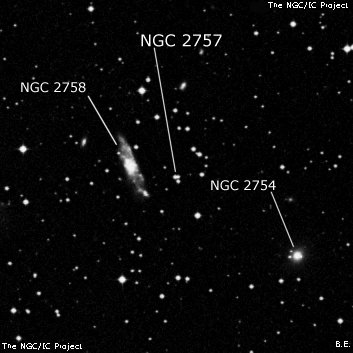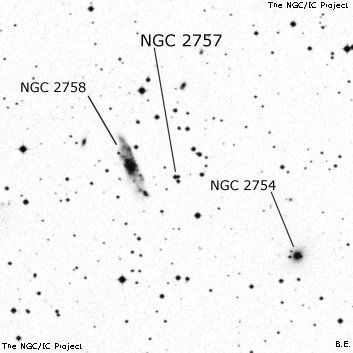NGC/IC Project Restoration Effort
(This is a very very beta version)
NGC2757


Basic Information
Location and Magnitude
Right Ascension: 9:5:23.4
Declination: -19:2:5
Constellation: HYA
Visual Magnitude:
Historic Information
Discoverer: Muller
Year of discovery: 1886
Discovery aperture: 26.3
Observational
Summary description: eF, 2nd of 3, ? *
Sub-type: *2
Corwin's Notes
=====
NGC 2757 is probably a triple star. It and two other objects, NGC 2754 and
NGC 2758, were found by Frank Muller at Leander McCormick in 1886 or 1887.
This is one case where the Leander McCormick discovery positions are quite
good, so the identities of N2754 and 2758 with two neighboring galaxies are
not in doubt. However, the third position of Muller's trio falls in a region
where only stars are found.
Herbert Howe, working with the 16-inch at Chamberlain Observatory in Denver
around the turn of the century, noticed a double star near Muller's place.
This is a relatively bright (15th magnitude), wide (12 arcsec) double, and I'd
be surprised if Muller mistook it for a nebula in the 26-inch, even on a night
of rather poor seeing. The 26-inch is optically quite good, and will
certainly show fainter objects with considerably more clarity than any
16-inch, all else being equal.
About an arcminute south-southeast of the double star, however, is a triple
star of about the same total magnitude. The separation of the components is
much less than the separation of the double's two stars. The triple was in
fact picked up as a single non-stellar object by the Guide Star Catalogue
software. My guess is that this is actually the object that Muller mistook as
nebulous. The position, while a minute or so further from Muller's than the
double star's position, is well within the usual Leander McCormick standard
deviation. So, while we can't be certain about the identification (there is
no surviving sketch), I'm going to take the triple as NGC 2757.
Steve's Notes
=====
NGC 2757
17.5" (2/8/97): this is a faint, close triple star (components mag 15) located 1.3' W of NGC 2758. In my observation of NGC 2758, this triple appeared nebulous and I sketched it as a probably nonstellar companion (slightly elongated with a nearly stellar core)! Howe identifies a wider pair close NW as NGC 2757.



